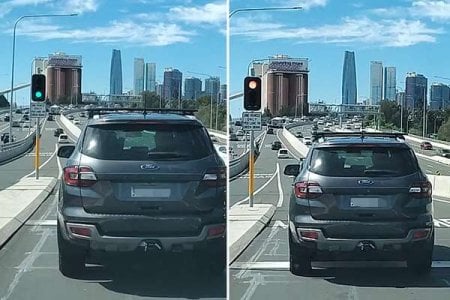This Aussie driver had a heated reaction at the lights—and others totally get why
By
Maan
- Replies 15
A baffling moment has left drivers scratching their heads after footage emerged of a traffic light behaving in an unexpectedly erratic manner.
With rush hour traffic already testing the patience of Sydney motorists, this latest incident has sparked a debate on how our roads are managed.
What caused the light to switch so rapidly, and what does it reveal about traffic management strategies?
A strange traffic light malfunction sparked confusion and frustration among Sydney drivers after dashcam footage revealed a light switching from red to green—and back to red—in just seconds.
The footage, captured by a motorist at the notoriously congested Rozelle Interchange, showed the driver waiting at a set of lights in the right lane, hoping to merge onto the Anzac Bridge.
However, only one or two cars managed to pass through before the lights flickered from red to green and back to red again, leaving the motorist stranded.
The video quickly went viral, with hundreds of people commenting in surprise at how fast the traffic lights were changing.
Some viewers were left wondering what caused the glitch, while others speculated about the traffic management system in place.
Hussein Dia, Professor of Urban Mobility at Swinburne University, explained that what many thought was a malfunction was actually a traffic management system called ramp metering.
Dia clarified that ramp metering is a key component of managed motorway operations and is used across various parts of Australia to help reduce congestion, especially in areas where traffic from on-ramps merges with the main motorway lanes.
'You can see the traffic merges near the horizon in the video,' he said.
Ramp metering works by coordinating the flow of vehicles from on-ramps, releasing one vehicle at a time to prevent bottlenecks at merging points, improving the overall efficiency of traffic flow.
'Usually, one vehicle is released per short cycle,' Dia added.
'They are implemented in many cities around the world to help ease congestion and improve safety. The ones running in Victoria have very sophisticated coordination algorithms.'
Source: Reddit
Melbourne’s ramp metering system is among the most advanced, using real-time data from road sensors to adjust the release rate of vehicles and prevent traffic build-up.
This system helps maintain smoother traffic flow, reduce stop-start driving, and ultimately cut down on travel times, which has made Victoria a leader in this area.
Although some motorists were critical of the system, calling it frustrating, others acknowledged its effectiveness.
'It's ramp metering. It limits the amount of traffic that can merge to prevent the main arterial route from clogging up and slowing down,' one commenter explained.
'Do they work? Absolutely. Does it suck having to sit in stop-start traffic for a while? Also absolutely.'
A second driver shared their frustration, saying: 'I am kinda surprised that [original poster] hasn't experienced these before, mustn't head out west often, at least not in peak times. They do work, sometimes. The issue I have with them is they still don't help those who shouldn't be driving on motorways to merge.'
Others supported the system, with one commenter pointing out: 'They do work if people use them properly. I drive all day around Sydney and there’s always the f****** i***** that just ignore them and sail on through.'
While the system is designed to alleviate traffic congestion, the mixed reactions highlight the ongoing debate over its effectiveness and the challenges of managing Sydney's busy roads.
In a previous story, we explored how confusing road signs have been baffling drivers across the city.
With so many drivers struggling to make sense of these signals, it's clear that Sydney's roadways are full of surprises.
If you missed it, be sure to check out what happened next!

With ramp metering systems becoming more common, do you think they’re the solution to Sydney’s traffic woes? Share your thoughts in the comments!
With rush hour traffic already testing the patience of Sydney motorists, this latest incident has sparked a debate on how our roads are managed.
What caused the light to switch so rapidly, and what does it reveal about traffic management strategies?
A strange traffic light malfunction sparked confusion and frustration among Sydney drivers after dashcam footage revealed a light switching from red to green—and back to red—in just seconds.
The footage, captured by a motorist at the notoriously congested Rozelle Interchange, showed the driver waiting at a set of lights in the right lane, hoping to merge onto the Anzac Bridge.
However, only one or two cars managed to pass through before the lights flickered from red to green and back to red again, leaving the motorist stranded.
The video quickly went viral, with hundreds of people commenting in surprise at how fast the traffic lights were changing.
Some viewers were left wondering what caused the glitch, while others speculated about the traffic management system in place.
Hussein Dia, Professor of Urban Mobility at Swinburne University, explained that what many thought was a malfunction was actually a traffic management system called ramp metering.
Dia clarified that ramp metering is a key component of managed motorway operations and is used across various parts of Australia to help reduce congestion, especially in areas where traffic from on-ramps merges with the main motorway lanes.
'You can see the traffic merges near the horizon in the video,' he said.
Ramp metering works by coordinating the flow of vehicles from on-ramps, releasing one vehicle at a time to prevent bottlenecks at merging points, improving the overall efficiency of traffic flow.
'Usually, one vehicle is released per short cycle,' Dia added.
'They are implemented in many cities around the world to help ease congestion and improve safety. The ones running in Victoria have very sophisticated coordination algorithms.'
Source: Reddit
Melbourne’s ramp metering system is among the most advanced, using real-time data from road sensors to adjust the release rate of vehicles and prevent traffic build-up.
This system helps maintain smoother traffic flow, reduce stop-start driving, and ultimately cut down on travel times, which has made Victoria a leader in this area.
Although some motorists were critical of the system, calling it frustrating, others acknowledged its effectiveness.
'It's ramp metering. It limits the amount of traffic that can merge to prevent the main arterial route from clogging up and slowing down,' one commenter explained.
'Do they work? Absolutely. Does it suck having to sit in stop-start traffic for a while? Also absolutely.'
A second driver shared their frustration, saying: 'I am kinda surprised that [original poster] hasn't experienced these before, mustn't head out west often, at least not in peak times. They do work, sometimes. The issue I have with them is they still don't help those who shouldn't be driving on motorways to merge.'
Others supported the system, with one commenter pointing out: 'They do work if people use them properly. I drive all day around Sydney and there’s always the f****** i***** that just ignore them and sail on through.'
While the system is designed to alleviate traffic congestion, the mixed reactions highlight the ongoing debate over its effectiveness and the challenges of managing Sydney's busy roads.
In a previous story, we explored how confusing road signs have been baffling drivers across the city.
With so many drivers struggling to make sense of these signals, it's clear that Sydney's roadways are full of surprises.
If you missed it, be sure to check out what happened next!
Key Takeaways
- Dashcam footage showed a traffic light at Rozelle Interchange switching rapidly from red to green and back.
- The incident sparked confusion and debate over traffic management strategies.
- Hussein Dia explained that the lights were part of a ramp metering system designed to reduce congestion.
- Motorists had mixed reactions, with some praising the system's effectiveness while others found it frustrating.
With ramp metering systems becoming more common, do you think they’re the solution to Sydney’s traffic woes? Share your thoughts in the comments!








